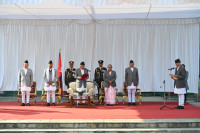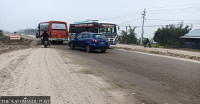National
Human-wildlife conflict continues
Human-wildlife conflict in various protected parks of the country, involving loss of life and properties, has continued in a similar manner like in the previous years.
Chandan Kumar Mandal
Human-wildlife conflict in various protected parks of the country, involving loss of life and properties, has continued in a similar manner like in the previous years.
At least 19 people were killed in wildlife attacks in the last fiscal year, while a large amount of properties were damaged by wild animals from the protected parks in the southern plains.
The highest human casualties in the fiscal year 2016-17 was reported in Chitwan National Park (CNP), where 13 people were killed by wild animals like tiger, elephant and rhino.
“Like previous years, incidents of human-wildlife conflict persists inside the park and its outskirts areas,” said Ram Chandra Kandel, CNP chief conservation officer.
The CNP had to pay Rs. 9.4 million as compensations and damages.
According to Kandel, more often than not humans are at fault when there are incidents of animals attacking people.
“Nearly 90 per cent of such incidents had happened as a result of people trespassing into the park. Wild animals are often blamed for such incidents, but the truth is they are simply guarding their territory,” said Kandel. “Animals get scared when they come across people. On many occasions, animals were provoked by people, resulting in attacks.”
Only a few incidents of human-wildlife conflict occur outside the park, the CNP officials said.
Last year, about 20 spotted deer were killed in road accidents in Tikauli forest along the East-West Highway.
This year, however, the number of roadkills has gone down after the CCTV cameras were installed to monitor the movement of vehicles.
Bardiya National Park (BNP) also witnessed a large number of human-wildlife conflicts, mostly caused by wild elephants.
According to Ramesh Thapa, chief conservation officer of the BNP, wild elephants killed six people and destroyed nearly 400 houses in the last fiscal year.
The park had pay nearly Rs 5 million in compensation.
The BNP also suffered a loss of one male tiger, which died after being hit by a
bus as it was crossing the road along the Karnali-Amreni section of the East-West Highway.
Hit-and-run cases also increased along the highway close to the BNP in last fiscal year.
In one of the incidents, a motorcycle rider had died on the spot after hitting a spotted deer, according to Thapa. “The park has been paying compensation from the government’s fund and from the local sources,” said Thapa.
The BNP has also been distributing monthly allowance of Rs 1,500 to single women, whose husband were killed in wildlife attack, and to those who suffered serious injuries in wildlife attacks.
After recently amending the directive on compensation concerning human-wildlife conflict, the government has decided to pay Rs 1 million for loss of life, Rs 200,000 for serious injury and Rs 20,000 for minor injury.
Similarly, the compensation amount of Rs 20,000 has been set for crop depredation by wild animals. These amounts were doubled with the second amendment to the directive.
No human casualties were reported in two other protected areas - Banke National Park and Parsa National Park (PNP) in FY 2016-17. However, wildlife from both parks had caused damage to crops and domestic animals.
Dil Bahadur Pun, chief conservation officer of Banke National Park, said although no one died in human-wildlife conflicts, wild boars and leopards had damaged crops and killed livestock around the buffer zone.
Such incidents were also reported in PNP.
“We can’t say what the trend is, but it has surely continued here,” said Hari Bahadur Acharya, PNP chief conservation officer. “Elephants, leopards and wild boars are the ones causing the most menace.”
The PNP has been working to minimise human-wildlife conflicts by helping local communities build fences.




 7.12°C Kathmandu
7.12°C Kathmandu















